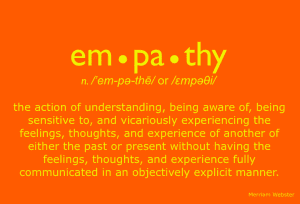Why is the user experience so poor?
 Trying to please all the people all the time
Trying to please all the people all the time- The underlying architecture is out-dated
- The navigation is confusing
- The images are too heavy (the site doesn’t load quickly)
- The website has been constructed by multiple people from multiple departments over a prolonged time
- Allocated resources were not sufficient
- The team is lacking the requisite skills
- The mobile version is nonexistent
- …
I marvel at how some sites are structured. You can still find sites that are set up merely according to the organization’s structure, with internal department titles lining the navigation tabs. Even worse, in-house jargon appears on the customer-facing website. How is the customer supposed to find satisfaction in such an environment?
3 keys to improve the user experience in an organization
Getting to a superior user experience requires taking strategic (i.e. tough) choices. Here are what I believe the three keys to help refine and define those choices:
 Understand better the Customer Journey. Empathy is a significantly important quality in understanding the customer journey. It is only truly possible to create a great user experience once you accept to get into the shoes of your customer. The key point is to understand fully the customer’s context at the time of contact. One of the cardinal sins of ‘traditional’ marketers is to do observation sessions of customers surfing in sterile conditions, based on a marketing script. {Tweet this!} An important part of creating a superior customer experience comes from understanding the customer’s situation at the time of interface (bandwidth, device, surroundings, time to spare, mindset…).
Understand better the Customer Journey. Empathy is a significantly important quality in understanding the customer journey. It is only truly possible to create a great user experience once you accept to get into the shoes of your customer. The key point is to understand fully the customer’s context at the time of contact. One of the cardinal sins of ‘traditional’ marketers is to do observation sessions of customers surfing in sterile conditions, based on a marketing script. {Tweet this!} An important part of creating a superior customer experience comes from understanding the customer’s situation at the time of interface (bandwidth, device, surroundings, time to spare, mindset…).- Breaking down silos. Most companies have a legacy structure that perpetuates silo building. I have seen many cases where web marketing teams are segregated from the rest of the business. In any event, that is too often how websites or apps are created: in virtual isolation from the rest of the business. In creating a customer experience, many people in the business beyond marketing need to be included, such as IT, sales/retail and customer service. I would further counsel, at least at the beginning, having a much wider net, including the CEO, HR Director (for better appreciation of the skillset required) and even the Finance Director. The point of having all members of the team participate in observation sessions (e.g. behind a one-way mirror) is to have the internal debate focused around the customers’ experience. This way, conversations move from “I don’t have the resources” or “I can’t do that” to “how can we improve what we just witnessed?”
- Aesthetics count and… it needs to work. Since technologies and usages are in constant flux, what constitutes a great user experience is also in movement. In order to get the user experience right, you clearly need to have the right talent. Taste and refinement are intangible qualities, but it’s all about the right attitude: to obsess about the look, the feel, the functionality, the navigation. Importantly, the individuals need to be curious and open to continuous learning, unlearning and relearning. If aesthetics are intimately related to brand image, functionality is related to simplicity. The challenge is to marry aesthetics with practical functionality.
To create an optimal customer journey is like engaging in a complex and long experiment. Not only are there different customer profiles to manage, there are scores of channels, platforms, devices from which to select before considering the appropriate timing and content. Digital is marvellous in that it allows for metrics that most executives would dream about. Unfortunately, few top executives have the measure of the options and data that digital affords.
When the conversation about building and designing a website or mobile app is oriented and focused around observations of a (real) customer’s experience, the internal silos and legacy problems are viewed with a different light. {Tweet this!} Nothing evaporates overnight, but at least the debate is organized around the person who is, ultimately, paying the bills and spreading the word: i.e. the consumer.

 Trying to please all the people all the time
Trying to please all the people all the time Understand better the Customer Journey. Empathy is a significantly important quality in understanding the customer journey. It is only truly possible to create a great user experience once you accept to get into the shoes of your customer. The key point is to understand fully the customer’s context at the time of contact. One of the cardinal sins of ‘traditional’ marketers is to do observation sessions of customers surfing in sterile conditions, based on a marketing script. {
Understand better the Customer Journey. Empathy is a significantly important quality in understanding the customer journey. It is only truly possible to create a great user experience once you accept to get into the shoes of your customer. The key point is to understand fully the customer’s context at the time of contact. One of the cardinal sins of ‘traditional’ marketers is to do observation sessions of customers surfing in sterile conditions, based on a marketing script. {









Many sites have excellent journeys but are not necessarily ending up where the visitor thought that they were going. Understanding exactly what the visitor wants is key. Unfortunately (in my experience) site designers, developers and content managers rarely think like the visitors that they want to attract. So how best to define such a basic requirement?
Spot on, as ever.